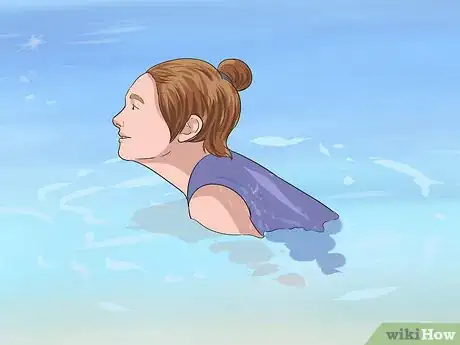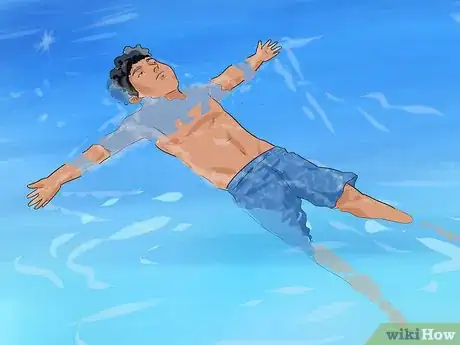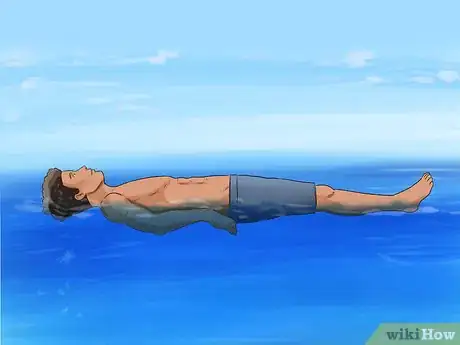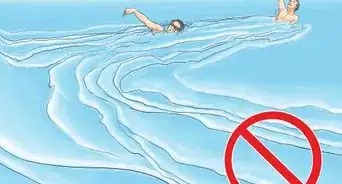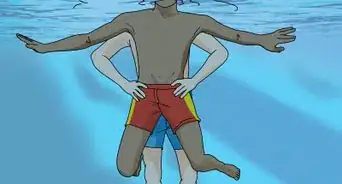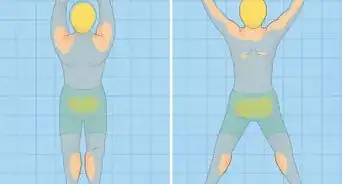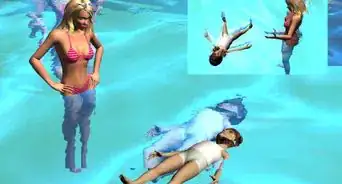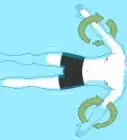This article was co-authored by Brad Hurvitz. Brad Hurvitz is a Certified Swimming Instructor for My Baby Swims, an adolescent swimming school based in La Jolla, California. Brad is trained as an Infant Swimming Resource (ISR) instructor with ISR's Self-Rescue® program. He specializes in training children aged six months to six years of age survival skills like floating on their back to breathe and swimming back to the wall, while also educating parents on how to better keep their kids safe. He has a Master of Business Administration from Oregon State University.
wikiHow marks an article as reader-approved once it receives enough positive feedback. In this case, 92% of readers who voted found the article helpful, earning it our reader-approved status.
This article has been viewed 167,902 times.
The dog paddle is a fast and fun way to move around the pool while keeping your head above water. It is also a good way for beginners to learn how to swim! You can do a dog paddle with or without a lifejacket.
Steps
Doing the Dog Paddle
-
1Get used to the water. Go to the shallow end of the pool and walk down the steps into the water. Spend a few minutes splashing around and getting used to the water. If you’re nervous about being in water try blowing some bubbles to relax. First, take a deep breath. Bend your legs until your face is underwater, keeping your eyes closed. Exhale slowly, blowing out bubbles. This will help you relax.[1]
- Don’t start swimming until you’ve relaxed. If you swim while you’re stressed out you risk injuring yourself or drowning.
- Try opening your eyes underwater while you blow bubbles. This will also help you relax.
-
2Position yourself to swim. Stretch your arms in front of you, keeping your head above the water. Stretch your legs loosely out underneath you. You can keep your feet on the bottom of the pool until you start swimming. Remember to breathe deeply and relax.[2]
- Don’t lie completely flat or stay completely horizontal. Try to find a point in between where your body is almost floating.
- Make sure to do this in shallow water. If you need to, you can stand up to breathe or float until you catch your breath.
Advertisement -
3Practice the arm motions. Cup both hands by pressing your fingers together tightly and bowing your palm out. Extend your hands one at a time and pull water towards yourself in a scooping motion. You will feel yourself moving forward a bit when you scoop the water. Practice this motion until you’re comfortable with it.[3]
- Some people prefer to scoop water in a downward motion instead of towards themselves.
- Your hands should be under the water at all times.
-
4Swim using your legs. Your legs will keep you afloat while your arms move you forward. While scooping water with your arms, kick your feet under the water. You can kick in a “bicycle” motion by kicking your legs in circles or a “frog kick” motion by kicking your legs out. Practice each kicking motion and decide which is more comfortable for you. [4]
- Breathe deeply. Keep your head over the surface of the water to allow you to breathe easily.
- If you find yourself struggling to swim or breathe, stand up and take a break.
-
5Alter your breathing technique if needed. If you find yourself straining your neck, keep your head close to the surface of the water. Raise your head above the surface when you want to inhale and slowly exhale while your face is in the water. Make sure you’re staying calm at all times.[5]
- If you’re having too much trouble keeping your head above water you need to paddle harder with your hands.
- If you find yourself getting worn out, either stand up or turn onto your back and float until you catch your breath.
-
6Correct swimming problems. If you’re having trouble staying close to the surface of the water this means you need to kick harder with your feet. Kicking your feet will keep you afloat but only if you’re kicking hard enough. Similarly, if you find yourself moving forward too slowly, paddle harder with your hands.
- If you’re scooping the water towards yourself, scoop the water down instead. You won’t go forward as fast but it will help you stay afloat.
- If you’re struggling to do a bicycle kick, switch to a frog kick (and vice versa).
Floating in Water
-
1Learn to float. Floating is a life-saving technique that will help you catch your breath. When you’re swimming in deep water, you won’t always have the opportunity to stand up or grab on to something to take a break. Furthermore, the dog paddle is a great swimming technique for beginners but it can tire a swimmer out easily. Learn to float to reduce the risk of drowning.[6]
- Practice floating in the shallow end of the pool. If you have trouble staying above the water you can stand up to catch your breath.
-
2Relax your body. It’s hard to float when your muscles are tensed up. Turn on your back in the water and stretch your arms and legs out, flattening your body.[7] Relax your neck and let your head dip into the water. However, make sure that your face doesn’t become submerged.
- If you’re worried about getting water in your ear, wear a swimmer cap while swimming.
- If you’re having trouble relaxing try closing your eyes while you float.
-
3Improve your buoyancy. First, breathe deeply. Filling your lungs with air will help you float above the water. If your legs are sinking too much, stretch your arms out behind your head, keeping them in the water. If you’re still having trouble keeping your legs afloat, kick your legs slightly.[8]
- If you’re having trouble breathing when you exhale, kick your legs slightly. This will help you stay afloat until you draw your next breath.
- Try to avoid using your hands to paddle. Instead, spread your hands and let your arms float.
-
4Float face down. Most people prefer to float on their backs so that they can breathe while they float. However, if you’d like to float face down, the technique is very similar.[9] Take a deep breath and hold it. Submerge your face in the water and stretch your arms and legs out like a starfish. When you need to breathe again, either stop floating or gently turn onto your back to take a breath.
- Push your chest into the water to help keep your legs afloat.
- Kick your feet gently if you’re having trouble floating.
Swimming Safely
-
1Stay calm. If you panic while you’re swimming you are at risk for drowning. Focus on your breathing and your form. If you’re in the deep end of a pool, calmly find your way to the shallow end. If you’re out in a larger body of water, look for something to stand on or something to hold on to.
- If you need help calming down, float on your back and focus on breathing deeply.
- When you panic, you become short of breath. This can make it harder to float.
-
2Wear a lifejacket. If you aren’t a confident swimmer wear a lifejacket, especially when you’re swimming in large bodies of water. An inexperienced swimmer can usually make it to the edge of the pool, but they might have trouble making it to the shore. Fortunately, you can use the correct dog paddle form when wearing a life jacket.[10]
- If you don’t want to wear a lifejacket but still want to be safe, use a Safer Swimmer. This is a small life buoy that attaches to a belt and floats behind you as you swim.
- When in doubt, have children wear a life jacket. It’s better to be safe than sorry.
-
3Swim responsibly. Never swim alone. If you have a panic attack in the water or have trouble staying afloat your friend will be able to help you. Try to swim at pools that employ lifeguards. Lifeguards are trained to help you if you’re drowning and to administer basic first aid.
- Have a cell phone nearby when you swim just in case you need to call your local emergency number.
- Always obey pool rules and regulations.
Community Q&A
-
QuestionWhat can I do if my head remains underwater during the dog paddle?
 Community AnswerIf your head is underwater, it is not a doggie paddle. Consider working on technique and working up to a basic freestyle. Coming from a former swimmer, the doggie paddle is about the worst thing you can do in the water. It tires you out very quickly and is not efficient at all. There are plenty of floats and different swim strokes that conserve energy and are very easy to do. Swimming on your back is also an option.
Community AnswerIf your head is underwater, it is not a doggie paddle. Consider working on technique and working up to a basic freestyle. Coming from a former swimmer, the doggie paddle is about the worst thing you can do in the water. It tires you out very quickly and is not efficient at all. There are plenty of floats and different swim strokes that conserve energy and are very easy to do. Swimming on your back is also an option. -
QuestionDoes pool water affect your eyes?
 Community AnswerIt varies from person to person. If you find that your eyes are sensitive to pool water, wear goggles while swimming.
Community AnswerIt varies from person to person. If you find that your eyes are sensitive to pool water, wear goggles while swimming. -
QuestionHow do I convince my mom to go swimming?
 Community AnswerTell her she can use a flotation device, and swimming is very good exercise.
Community AnswerTell her she can use a flotation device, and swimming is very good exercise.
Warnings
- When swimming in the ocean stay within sight of the shore and never swim alone.⧼thumbs_response⧽
- Practice caution when swimming in deep water.⧼thumbs_response⧽
References
- ↑ Brad Hurvitz. Certified Swimming Instructor. Expert Interview. 13 February 2020.
- ↑ https://www.youtube.com/watch?v=S-_5CdVxX3Q
- ↑ https://www.youtube.com/watch?v=hocP5YYZx2o
- ↑ https://www.youtube.com/watch?v=hocP5YYZx2o
- ↑ Brad Hurvitz. Certified Swimming Instructor. Expert Interview. 13 February 2020.
- ↑ Brad Hurvitz. Certified Swimming Instructor. Expert Interview. 13 February 2020.
- ↑ https://www.youtube.com/watch?v=sS0PZSrI-GI
- ↑ Brad Hurvitz. Certified Swimming Instructor. Expert Interview. 13 February 2020.
- ↑ https://www.youtube.com/watch?v=sS0PZSrI-GI
- ↑ Brad Hurvitz. Certified Swimming Instructor. Expert Interview. 13 February 2020.
About This Article
To dog paddle, start by stretching your arms in front of you and your legs loosely underneath you, while keeping your head above the water. With your feet still on the bottom of the surface, practice cupping both hands, extending your hands out one at a time, and pulling water toward you in a scooping motion. Once comfortable, kick your feet under the water using either a bicycle motion or frog kicks. If you have trouble staying afloat, kick your feet harder. To learn how to breathe while doing the dog paddle, keep reading!


